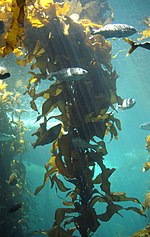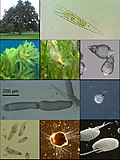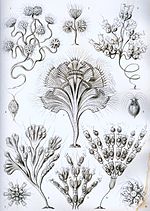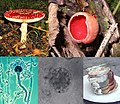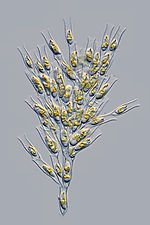of these hairs are exclusive to stramenopiles. The presumed apomorphy of tripartite flagellar hairs in stramenopiles is well characterized. The basal...
33 KB (3,303 words) - 21:11, 29 July 2024
with Stramenopiles replaced by its synonym Heterokonta in this variant of the acronym. Before the discovery of the SAR supergroup, stramenopiles and alveolates...
11 KB (1,083 words) - 20:45, 10 July 2024
which are found in coastal marine habitats. They are assigned to the Stramenopiles (heterokonts), a group which also contains kelp and various microalgae...
8 KB (752 words) - 22:28, 12 April 2024
phylogenetic lineage of fungus-like eukaryotic microorganisms within the Stramenopiles. They are filamentous and heterotrophic, and can reproduce both sexually...
20 KB (1,669 words) - 09:35, 2 May 2024
surrounding two singlets. Flagella may have hairs (mastigonemes), as in many Stramenopiles. Their interior is continuous with the cell's cytoplasm. Centrioles...
61 KB (6,087 words) - 12:28, 10 August 2024
stramenochromes, are a group of algae. They are the photosynthetic stramenopiles, a group of eukaryotes, organisms with a cell nucleus, characterized...
41 KB (4,135 words) - 07:25, 16 May 2024
environmental significance through carbon fixation. Brown algae belong to the Stramenopiles, a clade of eukaryotic organisms that are distinguished from green plants...
59 KB (5,896 words) - 09:02, 10 August 2024
Nanney & McCoy 1976 (Alveolata), Thalassiosira pseudonana Cleve 1873 (Stramenopiles), and Arabidopsis thaliana (Linnaeus) Heynhold, 1842 (Archaeplastida)...
8 KB (689 words) - 01:07, 12 August 2024
(male gametes), some gymnosperms (cycads and Ginkgo, as male gametes) Stramenopiles: centric diatoms (male gametes), brown algae (zoospores and gametes)...
13 KB (1,350 words) - 03:43, 17 June 2024
groups Excavata Diaphoretickes Hacrobia Cryptista Rhizaria Alveolata Stramenopiles Plants Amorphea Amoebozoa Opisthokonta Animals Fungi Mesomycetozoea)...
125 KB (11,194 words) - 22:57, 23 August 2024
British biologist Thomas Cavalier-Smith in 1981 to distinguish the stramenopiles, haptophytes, and cryptophytes. According to Cavalier-Smith, the kingdom...
26 KB (2,441 words) - 20:55, 15 May 2024
Labyrinthulomycetes are not fungi, but a monophyletic group of eukaryotes within the Stramenopiles. They belong to the phylum Bigyra, which contains other heterotrophic...
17 KB (1,380 words) - 08:27, 25 April 2024
as Spirostomum, can attain a length over 4 mm (0.16 in). The largest stramenopiles are giant kelp from the northwestern Pacific. The floating stem of Macrocystis...
22 KB (3,083 words) - 22:17, 17 August 2024
clade of three highly diverse lineages exclusively containing protists. Stramenopiles is a wide clade of photosynthetic and heterotrophic organisms that evolved...
94 KB (9,770 words) - 04:46, 23 August 2024
Bigyra contains many of the earliest-diverging clades of the Stramenopiles. The Stramenopiles are a supergroup of eukaryotic organisms (protists) characterized...
18 KB (1,612 words) - 18:17, 15 April 2024
groups Excavata Diaphoretickes Hacrobia Cryptista Rhizaria Alveolata Stramenopiles Plants Amorphea Amoebozoa Opisthokonta Animals Fungi Mesomycetozoea)...
137 KB (14,760 words) - 15:47, 20 August 2024
sequences was performed in 1996, which placed it into the group Stramenopiles. Other Stramenopiles include brown algae, mildew, diatoms, the organism that caused...
33 KB (3,865 words) - 20:40, 3 August 2024
and superphylum within Eukarya. They are currently grouped with the stramenopiles and Rhizaria among the protists with tubulocristate mitochondria into...
26 KB (2,694 words) - 23:49, 15 June 2024
Hyphochytrids are eukaryotic organisms in the group of Stramenopiles (Heterokonta). They are distinguished by an anterior tinsel flagellum on their zoospores...
6 KB (477 words) - 18:41, 15 April 2024
This list of sequenced algal genomes contains algal species known to have publicly available complete genome sequences that have been assembled, annotated...
41 KB (2,085 words) - 19:13, 18 August 2024
Excavata, Cristidiscoidea and Stramenopiles, respectively), water molds (oomycetes) and hyphochytrids (both Stramenopiles) were formerly classified in...
201 KB (19,177 words) - 13:51, 18 August 2024
the thraustochytrid stramenopiles. The QPX parasite is unicellular and possesses at least one flagellum, like most other stramenopile organisms. Thraustochytrids...
12 KB (1,410 words) - 01:04, 12 July 2024
groups Excavata Diaphoretickes Hacrobia Cryptista Rhizaria Alveolata Stramenopiles Plants Amorphea Amoebozoa Opisthokonta Animals Fungi Mesomycetozoea)...
24 KB (2,051 words) - 16:18, 22 August 2024
a polyphyletic assemblage of unrelated eukaryotic organisms in the Stramenopiles, Rhizaria, Discoba, Amoebozoa and Holomycota clades. Most are microscopic;...
54 KB (5,528 words) - 03:06, 16 July 2024
Synurophyceae are currently recognized as closely related taxa within the Stramenopiles. Present classifications include the synurids as an order (Synurales)...
7 KB (745 words) - 15:03, 21 May 2024
archaeplastidans: some green algae (e.g., Chlamydomonas, Zygnema, Chara) In stramenopiles: some golden algae In alveolates: many dinoflagellates, e.g., Ceratium...
24 KB (2,968 words) - 23:39, 24 April 2024
include: Actinophryida, Pedinellida and Ciliophryida (currently in Stramenopiles) Centrohelida (some support for Hacrobia) Desmothoracida, Heliomonadida/Dimorphida...
6 KB (505 words) - 15:56, 18 August 2024
groups Excavata Diaphoretickes Hacrobia Cryptista Rhizaria Alveolata Stramenopiles Plants Amorphea Amoebozoa Opisthokonta Animals Fungi Mesomycetozoea)...
95 KB (8,057 words) - 22:28, 24 August 2024
heliozoa, and other heterotrophic flagellates and is referred to as the Stramenopiles. The "primary" cell of chrysophytes contains two specialized flagella...
16 KB (1,596 words) - 15:34, 29 April 2024
Sagenista and Opalozoa. Together, Gyrista and Bigyra form the superphylum Stramenopiles or Heterokonta. A phylogenetic analysis in 2022 recovered a monophyletic...
12 KB (1,081 words) - 18:38, 15 April 2024






